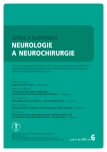Neurological Diagnoses in a Hospice Care – Two Case Reports
Authors:
M. Kala
Authors‘ workplace:
Hospic na Svatém Kopečku, Olomouc
; Fakulta humanitních studií, Univerzita Tomáše Bati ve Zlíně
Published in:
Cesk Slov Neurol N 2013; 76/109(6): 756-758
Category:
Case Report
Overview
The author presents two case studies of patients affected by severe neurological diagnoses. In the first case, a patient affected by progressive supranuclear paralysis was given palliative hospice care due to dismal clinical status and life-limiting terminal prognosis. The second patient, affected by multiple sclerosis, was given respite care. This also included percutaneous endoscopic gastrostomy insertion that not only contributed to stabilization of the patient’s condition but also allowed his wife, who was a carer, to recover.
Key words:
palliative care – respite care – hospice
The author declare he has no potential conflicts of interest concerning drugs, products, or services used in the study.
The Editorial Board declares that the manuscript met the ICMJE “uniform requirements” for biomedical papers.
Sources
1. Hromada J. Paliativní léčba a péče u nemocných s neurologickými chorobami. Neurol Prax 2010; 11(1): 7.
2. Ridzoň P, Mazanec R. Paliativní péče u terminálních stavů chorob motorického neuronu (amyotrofické laterální sklerózy, progresivní bulbární paralýzy a progresivní svalové atrofie). Paliat Med Liec Bole 2011; 4(1): 8– 10.
3. Sláma O. Podkožní aplikace léků a tekutin v paliativní medicíně. Onkologie 2008; 2(4): 246– 248.
4. Evans D. Exploring the concept of respite. J Adv Nurs 2012; 69(8):1905– 1915.
5. Shaw C, McNamara R, Abrams K, Cannings‑ John R,Hood K, Longo M et al. Systematic review of respite care in the frail elderly. Health Technol Assess 2009; 13(20): 1– 224.
Labels
Paediatric neurology Neurosurgery NeurologyArticle was published in
Czech and Slovak Neurology and Neurosurgery

2013 Issue 6
Most read in this issue
- Frontotemporal Lobar Degeneration from the Perspective of the New Clinical‑ Pathological Correlations
- Tuberous Sclerosis Complex in Children Followed from Neonatal Period for Prenatally Diagnosed Cardiac Rhabdomyoma – Two Case Reports
- Pineal Region Expansions
- Occipital Condyle Fractures
